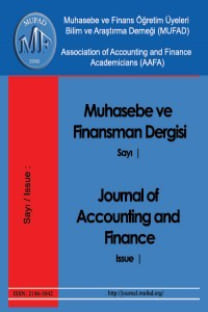Blok Zinciri Teknolojisinin Muhasebe Ve Finans Alanlarına Yönelik Yansımaları Ve Beklentiler
Blok Zinciri, Muhasebe, Finans, Dijitalleşme
___
- Alarcon, J. L., (2018), Blockchain and the Future of Accounting, Pennsylvania CPA Journa,, pp. 3-7.
- ASX, (2016), http://www.asx.com.au/documents/about/ASX-Selects-Digital-Asset-to-Develop-Distributed-Ledger-Technology-Solutions.pdf, (28.08.2017).
- AWS, (2016), “AWS Re: Invent 2016: Blockchain on AWS: Disrupting the Norm (GPST301)”, www.slideshare.net/AmazonWebServices/aws-reinvent-2016-blockchain-on-aws-disrupting-the-norm-gpst301, (28.08.2017).
- Bain & Company, (2016), Distributed Ledgers in Payments: Beyond the Bitcoin Hype. http://www.bain.com/publications/articles/distributed-ledgers-in-payments-beyond-bitcoin-hype.aspx, (09.09.2017).
- Bajpai, P. (2017), “The 6 Most Important Cryptocurrencies Other Than Bitcoin”, Investopedia, http://www.investopedia.com/tech/6-most-important-cryptocurrencies-other-bitcoin/, (27.08.2017).
- Berke, A. (2017), “How Safe are Blockchains? It depends”, https://hbr.org/2017/03/how-safe-are-blockchains-it-depends, (28.08.2017).
- Brennan, C., & Lunn, W. (2016), Blockchain: the Trust Disrupter, Credit Suisse Securities (Europe) Ltd.: London, UK.
- Broby, D., & Paul, G. (2017), The Financial Auditing of Distributed Ledgers, Blockchain and Cryptocurrencies, Journal of Financial Transformation, pp. 76-88.
- Buterin, V. (2014), “A Next-Generation Smart Contract and Decentralized Application Platform”, White Paper, https://www.ethereum.org/pdfs/EthereumWhitePaper.pdf/, (30.08.2017).
- Byström, H. (2016), Blockchains, Real-Time Accounting and the Future of Credit Risk Modeling, Working Paper/Department of Economics, School of Economics and Management, Lund University, (4), pp. 1-11.
- CAA. (2017), The Future of Blockchain: Applications and Implications of Distributed Ledger Technology, https://www.charteredaccountantsanz.com/-/media/c1430d6febb3444192436ffc8b685c7c.ashx, (09.09.2017).
- Dai, J., & Vasarhelyi, M. A. (2017), Toward Blockchain-Based Accounting and Assurance, Journal of Information Systems, 31(3), pp. 5-21.
- de Meijer, C. R. (2016), Blockchain and the Securities Industry: Towards a New Ecosystem, Journal of Securities Operations & Custody, 8(4), pp. 322-329.
- Espinel, V., O’Halloran, D., Brynjolfsson, E., & O’Sullivan, D. (2015), Survey Report: “Deep Shift: Technology Tipping Points and Societal Impact”, World Economic Forum, September.
- Fanning, K. & Centers, D. P. (2016), “Blockchain and Its Coming Impact on Financial Services”, J. Corp. Acct. Fin, 27, pp. 53–57. doi:10.1002/jcaf.22179
- Grinberg, R. (2011), “Bitcoin: an Innovative Alternative Digital Currency”, Hastings Science & Technology Law Journal, Vol. 4, pp.160-208, https://ssrn.com/abstract=1817857, (27.08.2017).
- Kosba, A., Miller, A., Shi, E., Wen, Z., & Papamanthou, C. (2016), “Hawk: The Blockchain Model of Cryptography and Privacy-Preserving Smart Contracts”, Security and Privacy (SP), 2016 IEEE Symposium, pp. 839-858.
- Mansfield-Devine, S. (2017), “Beyond Bitcoin: Using Blockchain Technology to Provide Assurance in the Commercial World”, Computer
- Fraud & Security, 2017(5), pp. 14-18. https://doi.org/10.1016/S1361-3723(17)30042-8
- Manta, O., & Pop, N. (2017), The Virtual Currency and Financial Blockchain Technology, Current Trends in Digital Finance. Financial Studies, 21(3).
- Mori, T. (2016), Financial Technology: Blockchain and Securities Settlement, Journal of Securities Operations & Custody, 8(3), pp. 208-227.
- Nakamoto, S. (2008), Bitcoin: A Peer-to-Peer Electronic Cash System. https://bitcoin.org/bitcoin.pdf, (27.08.2017). NASDAQ, (2016), http://www.nasdaq.com/article/colu-announces-colored-coins-and-lightning-network-integration-cm710111, (28.08.2017).
- Peters, G. W., & Panayi, E. (2016), “Understanding Modern Banking Ledgers Through Blockchain Technologies: Future of Transaction Processing and Smart Contracts on the Internet of Money”, Banking Beyond Banks and Money, pp. 239-278, Springer International Publishing.
- PWC, (2017), Global FinTech Report 2017, https://www.pwc.com/jg/en/publications/pwc-global-fintech-report-17.3.17-final.pdf, (28.08.2017).
- Simoyama, F. D. O., Grigg, I., Bueno, R. L. P., & Oliveira, L. C. D. (2017), Triple Entry Ledgers with Blockchain for Auditing, International Journal of Auditing Technology, 3(3), pp. 163-183.
- Underwood, S. (2016), Blockchain Beyond Bitcoin, Communications of the ACM, 59(11), pp. 15-17.
- VISA (2016), http://investor.visa.com/news/news-details/2016/Visa-Introduces-International-B2B-Payment-Solution-Built-on-Chains-Blockchain-Technology/default.aspx, (09.09.2017).
- Vranken, H. (2017), Sustainability of Bitcoin and Blockchains, Current Opinion in Environmental Sustainability, 28, pp.1-9.
- WEF, (2017). “Realizing the Potential of Blockchain, a Mutlistakeholder Approach to the Stewardship of Blockchain and Cryptocurrencies”, World Economic Forum White Paper, http://www3.weforum.org/docs/WEF_Realizing_Potential_Blockchain.pdf, (28.08.2017).
- Yermack, D. (2013), Is Bitcoin a Real Currency? An Economic Appraisal (No. w19747), National Bureau of Economic Research.
- Yermack, D. (2017), Corporate Governance and Blockchains, Review of Finance, 21(1), 7-31.
- ISSN: 2146-3042
- Yayın Aralığı: Yılda 4 Sayı
- Başlangıç: 2005
- Yayıncı: Muhasebe ve Finansman Öğretim Üyeleri Derneği (MUFAD)
Türk Bankalarında Mali Başarısızlığın Tahmin Edilmesine Yönelik Ampirik Bir Çalışma
Zeynep TÜRKCAN, Aslıhan BOZCUK, Kemal TÜRKCAN
IFRS 16 Kapsamında Kiralama İşlemlerinin Finansal Raporlamaya Etkisinin İncelenmesi
Makroekonomik Faktörlerin Hisse Senedi Getirilerine Etkilerinin BIST’de Araştırılması
Khatereh SADEGHZADEH, Bekir ELMAS
Benford Analizi İle Muhasebe Denetimi: Kamu Hastaneleri Üzerine Bir Uygulama
Mehmet Akif ÖNCÜ, Rahmi YÜCEL, Onur ÖZEVİN
Hilal Sarı ÖZGÜN, Hakan SARITAŞ
Belirsizlik Ortamında Nakit Varlıkların Değeri
Azize ESMERAY, Şükran GÜNGÖR TANÇ, Dilek ÇARDAK
Büyük ve Orta Boy İşletmeler için Finansal Raporlama Standardı ile VUK/MSUGT Karşılaştırması
Şirketlerin Bağımsız Denetim Raporlarının Analizi: Borsa İstanbul’da Bir Araştırma
Bilge SEKİZSU, Fatih Coşkun ERTAŞ
Blok Zinciri Teknolojisinin Muhasebe Ve Finans Alanlarına Yönelik Yansımaları Ve Beklentiler
